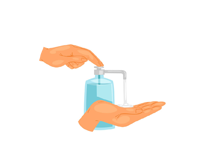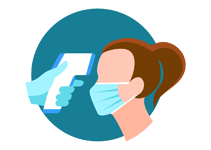Cefixime + Dicloxacillin
Cefixime + Dicloxacillin is a combination antibiotic commonly used to treat various bacterial infections affecting the respiratory tract, urinary tract, skin, and soft tissues. Cefixime inhibits bacterial protective covering, while dicloxacillin inhibits bacterial protein synthesis, decreases bacterial growth and development, and finally kills them. Together, they offer broad-spectrum antibacterial coverage, making the combination especially useful in mixed infections. This dual-action therapy helps enhance treatment effectiveness, reduce infection duration, and lower the risk of antibiotic resistance. By addressing multiple types of bacteria simultaneously, it provides a comprehensive, reliable solution for faster recovery and controlling infection.
Medicine Not Available for Cefixime + Dicloxacillin
Uses of Cefixime + Dicloxacillin
- Treats Respiratory Tract Infections: Effectively targets bacterial infections in the lungs and airways, such as bronchitis and pneumonia. It clears the infection, alleviating severe symptoms such as cough and congestion, ensuring a faster and complete recovery.
- Reduce Skin and Soft Tissue Infections. The medicine is prescribed for conditions like cellulitis, abscesses, and boils. It protects against various skin-infecting bacteria, preventing the spread of infection, reducing swelling and pain, and promoting proper healing.
- Manage Urinary Tract Infections (UTIs): Manages the infection of both the bladder and urinary system. The combination ensures better elimination of the bacteria, even in complicated cases. It quickly treats infection, easing pain when urinating and preventing kidney infection.
- Decrease Ear, Nose, and Throat (ENT) Infections: Kills bacteria in the ear, nose, and throat, quickly reducing pain, swelling, and fluid buildup. It helps treat ear, sinus, and throat infections and prevents them from becoming long-term problems.
- Prevents Post-Surgical Infections: Helps prevent infections after surgery. This combination reduces the risk of bacteria entering the surgical site, allowing the wound to heal properly without complications.
How Cefixime + Dicloxacillin Works
Cefixime works by interfering with the bacterial cell wall formation, causing the bacteria to rupture and die. Dicloxacillin, on the other hand, prevents bacteria from producing cell wall material, particularly targeting penicillin-resistant staphylococci. The combination of these two antibiotics allows for a broader spectrum of action, targeting a wider variety of bacterial pathogens.
Benefits of Cefixime + Dicloxacillin
- Provides broad-spectrum coverage against a variety of bacterial infections
- Effective in treating both Gram-positive and Gram-negative bacterial infections
- Penicillin-resistant bacteria can be targeted with Dicloxacillin
- Reduces the risk of bacterial resistance with combination therapy
- Convenient treatment option for managing multiple types of infections
How to Take Cefixime + Dicloxacillin
This combination antibiotic is typically taken orally, with the dosage depending on the type and severity of the infection. It is crucial to follow the dosage instructions provided by your healthcare provider or as stated on the prescription label. It is generally recommended to take these medications with a full glass of water, and it is best to complete the entire prescribed course even if symptoms improve to prevent resistance. Do not skip doses or stop taking the medication prematurely.
Type of Dosage Available
- Tablets
- Suspension (liquid form)
Side Effects of Cefixime + Dicloxacillin
- Common side effects may include nausea, vomiting, or diarrhea
- Possible allergic reactions such as rash, itching, or swelling
- Gastrointestinal discomfort like abdominal pain or bloating
- Rarely, severe allergic reactions or anaphylaxis may occur
- Changes in liver function, including jaundice or dark urine
Safety Advice
- Inform your doctor if you have a history of allergies, especially to penicillins or cephalosporins
- Ensure to complete the full prescribed course to avoid bacterial resistance
- Consult your doctor before use if you have kidney or liver problems
- May interact with other medications, so disclose all current medications to your healthcare provider
- Avoid taking antacids or iron supplements within 2 hours of taking Cefixime + Dicloxacillin
Frequently Asked Questions (FAQs)
Q. What is Cefixime + Dicloxacillin used for?
A. Cefixime + Dicloxacillin is used to treat bacterial infections such as respiratory tract infections, urinary tract infections, and skin infections, including those caused by resistant bacteria.
Q. How does Cefixime + Dicloxacillin work?
A. Cefixime interferes with bacterial cell wall synthesis, while Dicloxacillin targets penicillin-resistant staphylococci, providing broad-spectrum antibiotic coverage.
Q. What are the side effects of Cefixime + Dicloxacillin?
A. Common side effects include nausea, diarrhea, rash, and abdominal discomfort. Rare side effects can include severe allergic reactions or liver issues.
Q. How should I take Cefixime + Dicloxacillin?
A. It should be taken orally, as prescribed, with a full glass of water. Always complete the full course of antibiotics to ensure effectiveness and prevent resistance.
Q. Can I take Cefixime + Dicloxacillin with other medications?
A. Always inform your doctor of any other medications you are taking to avoid potential interactions.
Related Salt
Disclaimer : Zeelab Pharmacy provides health information for knowledge only. Do not self-medicate. Always consult a qualified doctor before starting, stopping, or changing any medicine or treatment.
Download India's most affordable pharmacy app
- Compare with medicine prices
- Save upto 90% on your medicine bills

Temperature Controlled storage and delivery

Regular Sanitization

Disinfected Packaging













 Added!
Added!